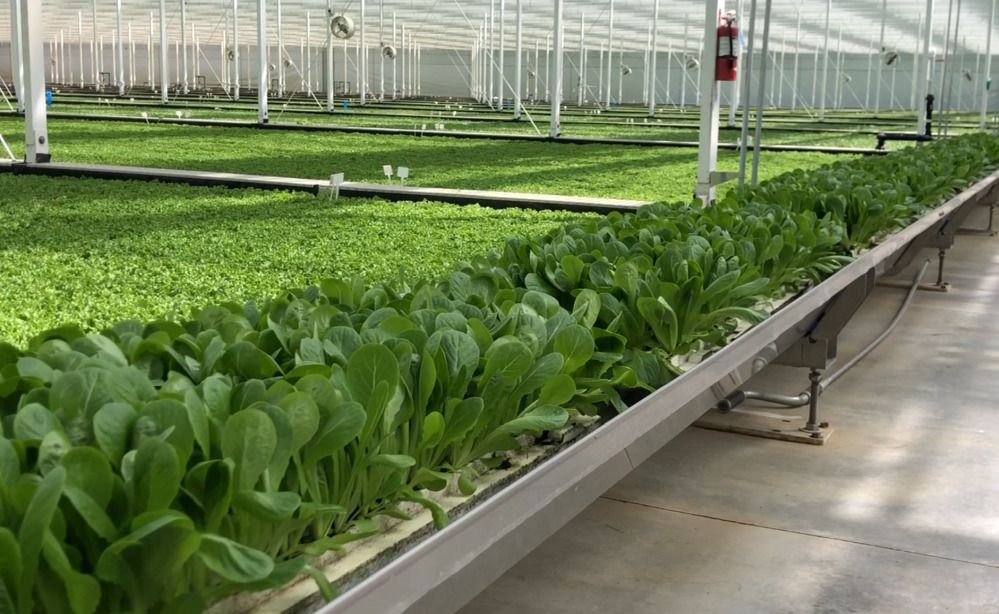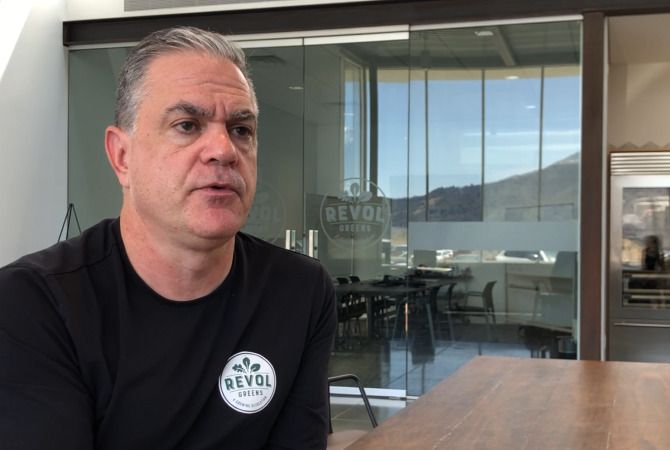The promise of a reliable supply of fresh, local produce with a pesticide-free positioning is alluring. But with controlled environment agriculture (CEA) startups dropping like flies, “jaundiced” investors are now laser-focused on models with proven unit economics and financial returns, Revol Greens CEO Michael Wainscott tells AFN on a tour of the firm’s vast hydroponic greenhouse in Tehachapi, California.
Plants, he observes, are not widgets that come out perfectly every time. Instead, they are living organisms that require careful handling, and investors that jumped into CEA with the hope of making a fast buck have got their fingers burned.
“People got so enamored with the shiny new toys and technology, that they forgot how efficient existing systems that they are trying to replace are. This is where the greenhouse market really blew it and why investors are a little bit jaundiced; these startups made it seem like you build a greenhouse and these plants come out like magic. But you can kill plants a million different ways.”
‘Agriculture is slow, biology is slow, and capital has to match the reality of the supply chain and the life cycle of these businesses’
But it is possible to make money from hydroponics, albeit not overnight, insists Wainscott, who operates greenhouses in Minnesota (10 acres), Georgia (4 acres), and California (16 acres, with room to increase to 32 acres). It is also gearing up to open a 20-acre facility in Texas (with room for expansion) billed as “the biggest indoor farm in the world.”
And crucially, he says, while some fair-weather investors have jumped away after getting their fingers burned, they have left behind a core group of “long-term serious, billion dollar investment groups focusing in on the space, from Cox [which owns Bright Farms], to TPG [key investor in Little Leaf Farms], to Ares] key investor in Gotham Greens], to Equilibrium Capital [key investor in Revol Greens].”
‘Profitability is our focus’
So how much money has Revol Greens raised, and can it demonstrate a clear path to profitability?
“From an equity standpoint, we raised a little over $100 million,” says Wainscott. “We own a couple of our facilities, but the others are leased from Equilibrium Capital [the biggest investor in Revol Greens], which is looking at long-term assets that can deliver stable returns.
“What’s great is that they’re not looking at this with a PE [private equity] five to seven year [expectation of a return on investment] lens. Agriculture is slow, biology is slow, and capital has to match the reality of the supply chain and the life cycle of these businesses.”
That said, “You still have to be able to show that you can produce it, distribute it, sell it, and have money at the end,” he says. “Profitability is our focus and that’s what we’ve been able to demonstrate in our facilities.”

‘Greenhouses have really been the ones that have come to solve the scale issue’
As for winning business models, it’s still early days for the industry, says Wainscott, who says there’s no one-size-fits-all approach. For sheer scalability, however, vast modern greenhouses primarily utilizing natural light supplemented by LEDS rather than vertical farms relying entirely on LEDS seem to be a better bet, at least for now.
“Initially, you saw a huge amount of growth in the vertical farming space… and then over time, what we’ve seen is that greenhouses have really been the ones that have come to solve the scale issue,” claims Wainscott, who says Revol is progressively layering in improvements at new plants to drive efficiency as it learns from previous builds.
“You walk into this facility and you can quickly say ‘I can see how this can feed thousands and thousands of people.’ This is an automated facility that’s built for scale.”

‘Customers don’t care what technology you have, they care if you have a better product’
Technology, however, is just a tool, he says. “Customers like it that we’re produce people, we talk about the product and the deliverables. We don’t say we’re running an automated greenhouse. What does that even mean?”
He adds: “They like the fact that we’re agriculturalists, that we’ve worked in produce before, and I was a CFO at a grocery store chain. Ultimately, they don’t care what technology you have, they care if you have a better product. What’s exciting is that before we open a new facility, we can be 75-80% sold before we open the doors, because we’re a proven quantity.”
Shiny new things
As for what technology to deploy, you don’t have to do everything yourself, he stresses. “Everyone has been trying to bring investors in on a shiny new thing they’ve developed, but we’ve focused on using best of breed [third-party] systems and programs.”
One such is from Dutch firm Blue Radix, which started working with Revol Greens last spring, says Wainscott.
Using AI, Blue Radix determines the optimal greenhouse climate every few minutes, combining inputs from plant and climate sensors, historical data and multi-day weather forecasts, giving Revol Greens precise control over temperature, humidity, carbon dioxide and lighting, helping to increase yields and reduce energy costs.
“We’ve deployed it at our Minnesota facility and we’re getting ready to deploy it here in California.”

Produce varieties best-suited for indoor ag
Separately, says Wainscott, who worked at plant science firm Benson Hill before taking the helm at Revol Greens in early 2021, more work needs to be done on developing produce varieties best-suited to indoor growing, which currently accounts for a tiny percentage of leafy greens production in the US.
“We’re partnering with different seed houses to help develop the better varieties and find the ones that make the most sense in a greenhouse.”
The consumer proposition of hydroponics: Fresh, local, pesticide-free
So what’s the benefit of produce grown indoors in water rather than outdoors in soil?
At a basic level, CEA is about being able to exert greater control over the growing environment, says Wainscott. It’s about slashing water use, speeding up growing cycles, increasing yield per acre, and creating a more consistent product.
For retailers and foodservice customers, meanwhile, Revol Greens’ products offer more shelf-life and greater security of supply than produce shipped from the west coast that is more vulnerable to weather and supply chain disruptions, he says.
Although there’s no room for complacency, there’s also a lower risk of foodborne illness versus produce grown outdoors as there is a shorter, simpler supply chain, says Wainscott, who notes that recalls associated with fresh produce are often caused by groundwater contaminated with livestock waste.
“We capture rainwater on our roofs that we sanitize before it goes into the facility. Much of it ends up in the leaves of the plants, but what’s left stays in the ponds, which go through a continuous filtration and cleaning process.”
Consumers, in turn, see products with a “fresh,” “local,” and “pesticide-free” positioning, he says.
“Most leafy greens grow in Salinas and if they’re going to the East Coast, they may have 2,000 miles and five days of transport on them by the time they arrive. At that point, they’ve already lost a majority of their nutritional value, whereas our product is harvested and on grocery store shelves within 24 or 48 hours, so it’s super fresh, super crisp, nutritious and delicious.”
‘We’re going to have to get to price parity across every variety’
That said, pricing will have to come down before hydroponically-grown produce becomes ubiquitous, he says: “If you go to the grocery store you’ll see premium organic kits and our premium kits to be very similar in price.
“But we’re going to have to get to parity across every variety we do. And that’s going to happen through improvements in greenhouse efficiencies, improvements in genetics… [while outdoor-grown produce is] probably going to get more expensive as they deal with labor, weather, and supply issues.”
He adds: “A lot of what impacts outdoor [agriculture], will impact the adoption of indoor [agriculture]: Are we going to see continued water restrictions in Arizona? Are we going to see some of the challenges we’ve seen in Salinas this year with floods?”
Further reading:
Q&A: Fifth Season’s former VP on why it failed and how vertical farming must change




